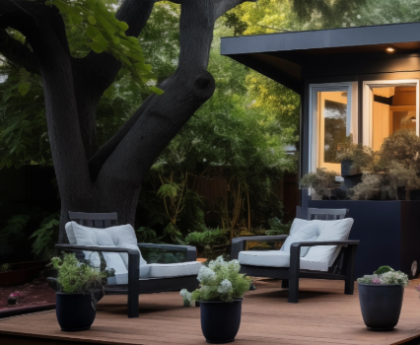With housing shortages on the rise and property prices going through the roof, California is paying more attention to Accessory Dwelling Units (ADUs). You might know them as granny flats, in-law units, or backyard cottages. ADUs are a great way to make the most of your property and provide affordable places to live right in your existing neighborhood. In big cities like Los Angeles, there’s a growing number of these units popping up without the proper permits.
The state is now working hard to make sure these homes are safe, and legal, and helping to ease the housing crunch. A lot of homeowners skip getting the right permits because it can be a big headache and cost a pretty penny. But the risks of not having your ADU up to code can be major, from safety issues to some serious fines. This guide is all about helping you figure out how to legalize ADU in California, especially looking at what’s new and important for 2024. So, if you’re looking to avoid trouble and make your ADU a legit part of your home, stick around. We’ll walk you through what you need to know to get things squared away without losing sleep or breaking the bank.
Understanding Unpermitted ADUs
What Makes an ADU Illegal?
An ADU becomes illegal, or unpermitted, mainly when it’s built without the necessary permits and inspections from local authorities. These permits make sure that the building meets safety standards, fits with zoning laws, and follows building codes, which all help keep residents safe and maintain the look and feel of the community.
Why Do Some Homeowners Skip Permits?
Building an ADU with all the required permits can be expensive and time-consuming. To save money and hassle, some homeowners skip this step, hoping to rake in some quick rental cash. However, this shortcut can lead to big headaches down the road, like legal issues and problems selling the home.
What Are the Risks of Having an Unpermitted ADU?
Having an ADU without the right permits is risky. Safety-wise, if the unit isn’t built to stand up to things like earthquakes or fires, it could be dangerous for anyone living there. On the legal side, you might face fines, the possibility of having to tear the building down, and trouble getting the unit approved later on, which can mess up your finances and legal standing. Getting your ADU permitted isn’t just about following the rules—it’s also a big step towards solving the housing shortage by making sure all homes are safe and livable.
Why Legalizing Your ADU Matters
Boosting Affordable Housing
By making ADUs legal, California is taking a big step toward increasing affordable housing options. Homeowners can rent out these spaces, offering more budget-friendly living options than many traditional housing options, especially in cities where rents are skyrocketing faster than most people’s paychecks.
The Dangers of Skipping Permits
Keeping an ADU unpermitted can lead to some serious problems. Homeowners might face large fines, legal trouble, and even the risk of eviction notices for tenants. This can throw people’s lives into chaos and hit your wallet hard. Plus, if these units aren’t up to safety standards, they could be downright dangerous in an emergency.
The Upsides of Making Things Official
When you legalize an ADU, you’re making sure it meets all the local building codes, which slashes the risk of legal headaches and boosts the safety of the home. On top of that, a legal ADU can bump up your property’s value, making your home a hotter commodity if you decide to sell. Legalizing also means your rental income is on the up-and-up, giving you financial peace of mind. Understanding all this shows why it’s smart—and right—to legalize your ADU. Not only does it keep you on the right side of the law, but it also does a solid for your community by keeping standards high and ensuring everyone’s safety.
Exploring Your Options for Unpermitted ADUs
When you find out your ADU isn’t permitted, you’ve got a couple of choices on how to handle it:
Option 1: Bring It Back to the Original
• What You Need to Do: This means you have to undo any unpermitted work. For instance, turn a garage that’s been converted into a living space back into just a garage.
• Pros: This is usually faster and involves less red tape. It’s a straightforward way to fix legal issues without diving into a big remodeling project.
• Cons: The downside is you’ll miss out on extra rental income and the added value a legal ADU could bring to your property.
Option 2: Make the ADU Legal
• What You Need to Do: This path requires getting the right permits and passing inspections to make sure your ADU meets all building and safety standards. You might need to redraw your plans and make some changes to fit local zoning rules.
• Pros: Getting your ADU legalized can boost your property value, lock in legal rental income, and ensure the place is safe to live in. Plus, you’re helping ease the housing crunch by adding to the available homes in your community.
• Cons: This can be a pricey and slow process, especially if your original build didn’t follow the local codes and needs major work.
Deciding between these options should take into account your current situation, how much you can spend, and your plans for the future. While it might seem like a tough call, legalizing your ADU usually brings more benefits, helping both your wallet and your community in the long run.
Your Step-by-Step Guide to Making Your ADU Legal
Step 1: Check Out Your Current ADU
First things first, figure out what needs to change to meet local regulations. This involves:
• Understanding the Rules: Every area has its own laws for ADUs. You’ll need to talk to your local planning department to get the scoop on what’s required.
• Bringing in an Expert: It’s smart to hire someone who knows the ins and outs of local ADU laws. They can do a thorough check-up of your place and spot any big issues with things like size, height, how far it is from your property line and utilities.
Step 2: Plan Your Changes
Once you know what’s needed, it’s time to plan:
• Get Professional Help: Hire an architect or designer who’s got experience with ADUs. They can create plans that not only tick all the legal boxes but also make your space as nice and functional as possible.
• Refine Your Plans: You might have to tweak your plans a few times to get everything just right, so stay flexible.
Step 3: Get Your Plans Approved
Now, you’ll need to get the green light from the powers that be:
• Submit Your Plans: Take your detailed plans to the local building department for their approval.
• Adjust as Needed: Be ready to make changes based on their feedback. This can take a few tries, so patience is key here.
Step 4: Build It Right
Time to turn those plans into reality:
• Choose a Savvy Contractor: Make sure your contractor has experience with ADUs and knows local codes well.
• Keep an Eye on Things: Stay on top of the building process to ensure everything matches your approved plans and meets code requirements.
Step 5: Cross the Finish Line with Inspections
Almost there—just need to dot the i’s and cross the t’s:
• Line Up Inspections: You’ll need several inspections to make sure everything from the wiring to plumbing and the overall build is up to snuff.
• Secure Your Occupancy Permit: Once you pass all inspections, you’ll get an occupancy permit, which officially makes your ADU a legal living space. Getting your ADU legalized might seem like a lot of hoops to jump through, but it’s all about making sure your space is safe to live in and can be a legitimate part of your property. Hang in there—it’s worth it for the peace of mind and the benefits it brings!
Breaking Down the Costs and Financing of Legalizing Your Unpermitted ADU
Understanding the Costs
The price tag for making your ADU legal can be all over the place, depending on a few key factors:
• What Needs Fixing: Minor updates like putting in smoke detectors or updating the wiring might not set you back too much. But if you need to overhaul the structure, the costs can shoot up.
• Local Rules and Fees: The fees for permits, inspections, and sorting out any zoning issues can vary a lot depending on where you live.
Estimated Costs
You could be looking at spending anywhere from a couple of thousand bucks to over $100,000. It all depends on how much needs to change to bring your ADU up to the current building codes.
Financing the Legalization of Your Unpermitted ADU
How to Fund the Upgrades

Making your ADU legal isn’t cheap, but thankfully, there are a few ways to find the money you need:
• Renovation Loans: These are specifically for funding updates and changes needed to make your ADU meet legal standards.
• Home Equity Line of Credit (HELOC): If you’ve got equity in your home, a HELOC gives you a flexible way to pull funds for improvements.
• Cash-out Refinance: This option lets you refinance your existing mortgage and take out extra cash based on the equity you have in your home, perfect for big renovations.
Local Help Might Be Available
Check out if your local government offers any grants or programs aimed at helping homeowners with ADUs, especially if your upgrades will help boost affordable housing options. Levi Construction can assist you with this process.
Why It’s Worth the Investment
Sure, the initial costs can be steep, but legalizing your ADU can boost your property value and bring in regular rental income. Plus, getting legal means you dodge hefty fines and legal troubles down the road. Investing in making your ADU legit could save you a lot of money and stress later on.







